|
|
Welcome to Dunton
Family Farms
|
|||||||||||||||||||||||||||||||||||||||||||
The "Hay Barn" The hay barn . . . what can I say. It is my favorite place on the farm. I spend more time in there than I do in the house. In modern housing construction, homes are built for the purpose of being a place to get away from the stress of the world - a sanctuary and a place to congregate. With modern people having such separated lives (spouses with separate jobs, kids at separate schools and all participating in their own separate leisure time activities), the home is the one place to come together as a family, decompress, and reconnect. In the not too distant past, especially pertaining to farms, houses were multi-use buildings that were used to augment daily life. As with other farm buildings, they served a distinct purpose. People were born in them, they were schooled in them, they ate and slept in them, they held family events and holiday feasts, and front parlors were even used to prepare and display bodies of the recently departed for service (as opposed to funeral parlors). As a family, we sit somewhere in between the old and new models mentioned above. The challenge for us is maintaining the balance. One blessing bestowed on us is that that we are able to live our lives, all of our lives, centered around this piece of land that our ancestors settled on. And out of all of the physical structures here, the "hay barn" is the nucleus. Historically, the "hay barn" has always had a a diverse set of uses. It is built over a hillside with the upper part being used primarily to store the hay crop as well as grain. The lower level of the barn was the milking parlor and also contained a pen which was used for taking care of sick animals or for "graining" them to prepare them for butchering. Although the roof was in pretty good shape (corrugated galvanized steel over an old cedar shingle roof), it had developed a couple of small leaks. As this is an important structure for us, and since we hope to house the historical horticultural library someday, this project became our number one maintenance project for 2004. The old roof was removed and it was then sheathed with plywood, roofing felt, and covered with an architectural grade composition roofing. This sealed it up nicely and last 30 or 40 years. We used the same roofing contractor, Bower Roofing, as we did for the house in 2000. |
|||
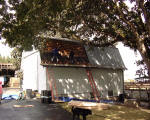 9/13/04 - Hay Barn 11:00 a.m. |
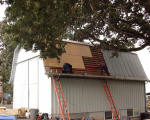 9/13/04 - Hay Barn 1:00 p.m. |
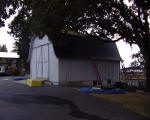 9/14/04 - Hay Barn 7:00 a.m. |
|
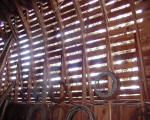 9/14/04 - Hay Barn Inside 8:00 a.m. |
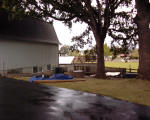 9/14/04 - Hay Barn 4:30 p.m. |
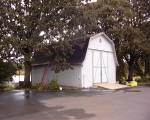 9/14/04 - Hay Barn 4:30 p.m. |
|
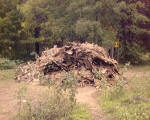 9/14/04 - The growing burn pile made up of the barn's original cedar shake roof. |
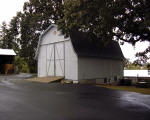 9/16/04 - Completed |
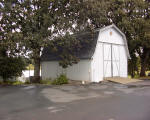 9/16/04 - Completed |
|
|
Barn Statistics: The barn measures about 25' x 36'. It is 20 feet tall to the peak on the south face and because is is built over a hillside, about 30 feet tall on the north face. The barn was built in the early 1940s on the concrete foundation of an older (age unknown) structure. The old foundation was a hand pour, done in layers, and badly crumbling and becoming unstable. In about 1998 we jacked the barn off of the concrete and placed the load on new perimeter beams and posts. In 2001 we had a contractor pour a new foundation on the inside of the old one. Machine Shed This building, as you can see in the pictures, is a multi-use storage building. It holds the farm machinery and part of our woodpile. The roof was in dire need of repair when we purchased the farm in 1988. About ten years ago I painted on a vinyl-based material that bought us some time but, the corrugated aluminum was badly oxidized (rotted). This at least kept it from leaking really bad and the wood structure looks sound. One future project is the framing in and enclosing of the front face of this building. This will accomplish several things. It will better protect the contents from the weather and potential security threats as well as eliminating a safety issue. The safety issue is an important consideration for opening to the public at a future date. |
|||
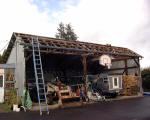 9/13/04 - Machine Shed 11:00 a.m. |
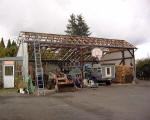 9/13/04 - Machine Shed 1:00 p.m. |
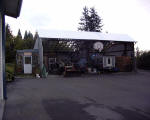 9/14/04 - Machine Shed 7:00 a.m. |
|
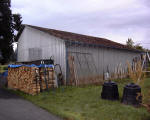 9/14/04 - Back of Machine Shed - 7:00 a.m. |
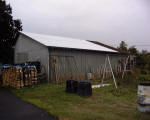 9/14/04 - Back of Machine Shed - 4:30 p.m. (They ran out of metal) |
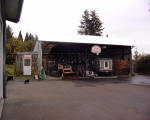 9/14/04 - Machine Shed 4:30 p.m. |
|
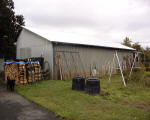 9/16/04 - Completed |
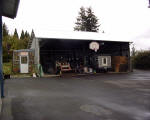 9/16/04 - Completed |
||
|
Loafing Barn Re-roof Another badly needed repair on the farm. The historical use of the structure was as a cattle shelter and manure storage. Looking into the open face of the building, the far right bay is called the manure pit. It has a trough that feeds it from above. This trough use to extend into the big barn above into what was once the milk barn (now our office). You will notice that there is a catwalk along the back wall. This is accessed from up above in the corral area. Above the manure pit is a space big enough to hold a ton or so of hay bales. This allowed for feeding into the manger along the bottom of the back wall. It was a nice setup for cattle. Now it is basically used as a storage area for fencing supplies and our wintering over place for tomato baskets (which take up a lot of space). The roof, like the machine shed, had a corrugated aluminum cover. It had tears and rot and holes from branches falling on it over the years. I have patched and made temporary repairs over the years but it really needed replaced. The new roof is corrugated galvanized steel. |
|||
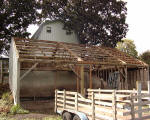 9/13/04 - Loafing Barn 11:00 a.m. |
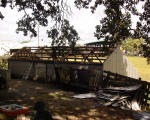 9/13/04 - Loafing Barn 11:00 a.m. |
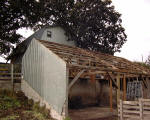 9/13/04 - Loafing Barn 11:00 a.m. |
|
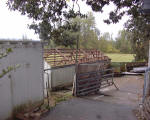 9/14/04 - Loafing Barn 7:00 a.m. |
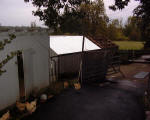 9/14/04 - Loafing Barn 6:30 p.m. |
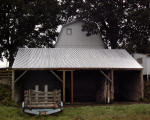 9/16/04 - Completed |
|
|
Loafing Barn Repair This is a project that had been put off for at least two summers. We purchased all of the lumber necessary for the temporary supports last summer and never got around to getting them in place. The building made it through winter (thankfully). Since we were committed to replacing the roofs on all of the outbuildings this year, it forced the repair to the active project schedule. But, as you will note by the dates, repairs were not completed until the evening before the roofing crew was scheduled to arrive. No reason the rush into things :) |
|||
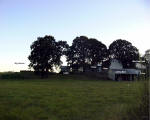 Farmyard Layout from bottom field facing South |
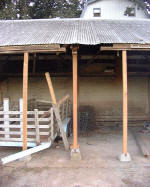 8/29/04 - Loafing barn repair with most rot removed and temporary supports in place. |
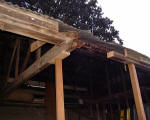 8/29/04 - Close-up |
|
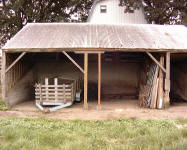 9/12/04 - Loafing barn repaired. |
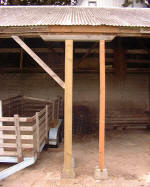 9/12/04 - Loafing barn repaired. |
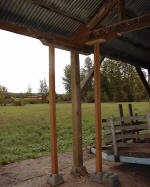 9/12/04 - Loafing barn repaired. |
|
